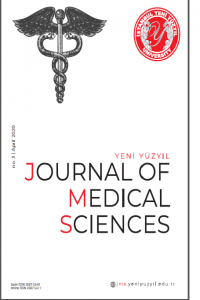Keman sanatçılarının sağ ve sol kulak işitmesinin odyolojik testlerle karşılaştırılması
Amaç: Yüksek şiddette müzik sesi üretebilen kemanın özellikle tutuş şeklinden dolayı sol kulağa yakınlığı sebebiyle daha fazla ses iletilmesi ve bu durumun odyolojik testlerle, sağ-sol kulak arasında anlamlı bir işitme farkı oluşturup oluşturmadığının tespit edilmesi, işitme kaybı var ise izlenmesi ve zamanında önlenebilmesine yönelik düzenlemelerin yapılabilmesi amaçlanmıştır.
Gereç ve Yöntem: Bu çalışmaya, uzun yıllar boyunca keman çalan, konservatuar mezunu, profesyonel olarak müzikle ilgilenen dolayısıyla her gün çalışma ve egzersiz yaparak müzik/gürültü sesine maruz kalan, 18-55 yaş arası kadın ve erkek yetişkin keman sanatçısı bireyler ile müzikle ilgisi olmayan ve enstrüman çalmayan 25 kişiden oluşan kontrol grubu dahil edilmiştir. Çalışma grubu ve kontrol grubu tüm bireylere saf ses odyometri, yüksek frekans odyometri, otoakustik emisyon ve timpanometri testleri ile odyolojik değerlendirme yapılmıştır.
Bulgular: Çalışmamızda keman sanatçısı grubu ve kontrol gruplarında veriler cinsiyete göre, sağ ve sol kulağa göre ayrı ayrı karşılaştırılmıştır. Sol kulak Yüksek Frekans 9000 Hz (p= 0,001, p
Anahtar Kelimeler:
Keman sanatçısı, yüksek frekans işitme kaybı, odyometri, sol kulak, gürültüye bağlı işitme kaybı.
Violinists comparison of right and left ear hearing with audiological tests
Aim: The violin, which can produce high-intensity musical sounds, transmits more sound due to its proximity to the left ear, especially due to the way it is held, and to determine whether this situation creates a significant hearing difference between the right and left ear with audiological tests, and to monitor if there is hearing loss and to prevent it in a timely manner.
Materials and methods: In this study, playing violin for many years, a graduate of the Conservatory of music, professionally interested in music, by exercising and working out every day, hence the music/noise exposed to the adult male and female individuals between the ages of 18-55 violinists who play music with the instrument and a control group of 25 subjects that have nothing to do was included. Audiological evaluation was performed by pure sound audiometry, high frequency audiometry, auto acoustic emission and tympanometry tests on all individuals in the Working Group and control group.
Results: In our study, data in violinist group and control groups were compared separately according to gender, right and left ear. 9000 Hz high frequency in your left ear (p= 0.001, p
Keywords:
Violinist, high frequency hearing loss, audiometry, left ear, noise-related hearing loss.,
___
- 1. Britannica. Violin. Encyclopaedia Brittanica. 2017.
- 2. Chasin M. Violin and viola players information sheetpart5. 2011. https://hearinghealthmatters.org.
- 3. Chasin, M. Music and hearing aids. The Hearing Journal 2003; 56(7): 36-38.
- 4. Rabinowitz, P. Noise-induced hearing loss. American Family Physician. 2000; 61(9): 2749-2756.
- 5. Everest, F.A., Pohlmann, K. C. Master handbook of acoustics. McGraw-Hill Education. 2015.
- 6. Ostri, B., Eller, N., Dahlin, E., Skylv, G. Hearing impairment in orchestral musicians. Scandinavian Audiology. 1989; 18(4): 243-249.
- 7. Dedecan M. Self-reported Hearing Status incompatible with the findings of audiometric testing in adults with High-frequency hearing, Masking level difference, Visual Disability, bodily sensations Exaggerate, depression and quality of life the findings of the Investigation. Ph. D. dissertation. Yıldırım Beyazıt University, Institute of Health Sciences. Ankara: Turkey. 2018.
- 8. Sindhusake, D., Golding, M., Newall, P., Rubin, G., Jakobsen, K., Mitchell, P. Risk factors for tinnitus in a population of older adults: the blue mountains hearing study. Ear and hearing. 2003; 24(6): 501-507.
- 9. Kähäri, K. R., Axelsson, A., Hellström, P. A., Zachau, G. Hearing assessment of classical orchestral musicians. Scandinavian audiology. 2001; 30(1): 13-23.
- 10. Kumdakci, S. Evaluation of hearing with audiometry and transient evoked otoacoustic emission tests in orchestra musicians. Master's thesis, Başkent University Institute of Health Sciences. Ankara: Turkey. 2016.
- 11. Ahmed, H. O., Dennis, J. H., Badran, O., Ismail, M., Ballal, S. G., Ashoor, A., Jerwood, D. High‐frequency (10–18 kHz) hearing thresholds: reliability, and effects of age and occupational noise exposure. Occupational Medicine. 2001; 51(4), 245-258.
- 12. Russo, F. A., Behar, A., Chasin, M., Mosher, S. Noise exposure and hearing loss in classical orchestra musicians. International Journal of Industrial Ergonomics. 2013; 43(6): 474-478.
- 13. Schechter, M. A., Fausti, S. A., Rappaport, B. Z., Frey, R. H. Age categorization of high‐frequency auditory threshold data. The Journal of the Acoustical Society of America. 1986; 79(3): 767-771.
- Başlangıç: 2019
- Yayıncı: İstanbul Yeni Yüzyıl Üniversitesi
Sayıdaki Diğer Makaleler
Almanya’da Mezuniyet Öncesi Tıp Eğitimi ve Aile Hekimliği Uzmanlık Eğitimi
Raphael KUNISCH, Metin CANBAL, Zekeriya AKTÜRK
Genç Bir Hastada Ameliyatla Tedavi Edilen Sigmoid Volvulus Olgusu
Tıbbi Ürünlerin Sterilizasyonu
Rümeysa KARAGÖZ, Hande ERENSOY, Gönül KUNT KANDEMİR
Keman sanatçılarının sağ ve sol kulak işitmesinin odyolojik testlerle karşılaştırılması
Özlem SALUR, Nebi Mustafa GÜMÜŞ
Bağımlı Bireylerin Yaşadıkları Ruhsal Sorunlar ve Önlemeye Yönelik Uygulamalar
Ayten ELVEREN, Merve BAT TONKUŞ, Şevval TOKMAK
Elektronik sigaraların yapay dişlerin renkleşmesi üzerine etkisi
